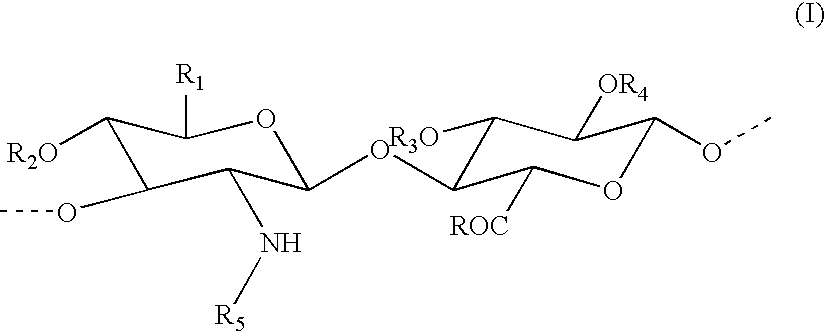Percarboxylated polysaccharides, and a process for their preparation
a technology of percarboxylated polysaccharides and polysaccharides, which is applied in the field of percarboxylated polysaccharides and a process for their preparation, can solve the problems of unpredictability and substantial degradation of polymers
- Summary
- Abstract
- Description
- Claims
- Application Information
AI Technical Summary
Problems solved by technology
Method used
Image
Examples
example 2
[0068] Preparation of percarboxylated hyaluronic acid in the form of a sodium salt with 50% percarboxylation
[0069] 1 g of sodium hyaluronate (2.5 mmoles) with a mean molecular weight of 200 KDa is solubilised in 50 ml of water. The solution is cooled in a bath with a thermostat set at -1.degree. C., and is then supplemented with 40 mg (0.26 mmole) of TEMPO and 260 mg (2.5 mmole) of NaBr (sodium bromide). A solution of 15% sodium hypochlorite is added in a quantity of 0.6 ml, equal to 1.25 mmole, corresponding to 50% of the moles of sodium hyaluronate present. The solution is mixed and the pH maintained at 9-9.2 by the addition of a solution of 0.1 M NaOH. Some minutes later, the pH remains stable with no further additions of this kind. A volume of absolute ethanol equal to 5 ml is added and the solution is neutralised by adding 1 M HCl until the pH reaches 6.9-7.2. Then 95 mg (2.5 mmoles) of sodium borohydride is added and the mixture is agitated overnight at room temperature.
[0070]...
example 3
[0074] Preparation of percarboxylated hyaluronic acid in the form of a sodium salt with 75% percarboxylation
[0075] 1 g of sodium hyaluronate (2.5 mmoles) with a mean molecular weight of 200 KDa is solubilised in 50 ml of water. The solution is cooled in a bath with a thermostat set at -1.degree. C., and is then supplemented with 40 mg (0.26 mmole) of TEMPO and 260 mg (2.5 mmole) of NaBr (sodium bromide). A solution of 15% sodium hypochlorite is added in a quantity of 0.9 ml, equal to 1.875 mmole, corresponding to 75% of the moles of sodium hyaluronate present. The solution is mixed and the pH maintained at 9-9.2 by the addition of a solution of 0.5 M NaOH. Some minutes later, the pH remains stable with no further additions of this kind. A volume of absolute ethanol equal to 5 ml is added and the solution is neutralised by adding 1 M HCl until the pH reaches 6.9-7.2. Then 95 mg (2.5 mmoles) of sodium borohydride is added and the mixture is agitated overnight at room temperature.
[0076...
example 4
[0080] Preparation of percarboxylated gellan in the form of a sodium salt with 50% percarboxylation
[0081] 2 g of gellan sodium salt (2.95 mmoles) with a mean molecular weight of 700 KDa is solubilised in 100 ml of water. The solution is cooled in a bath with a thermostat set at -1.degree. C., and is then supplemented with 40 mg (0.26 mmole) of TEMPO and 300 mg (2.9 mmole) of NaBr (sodium bromide). A solution of 15% sodium hypochlorite is added in a quantity of 0.705 ml, equal to 1.47 mmole, corresponding to 50% of the moles of gellan sodium salt present. The solution is mixed and the pH maintained at 9-9.2 by the addition of a solution of 0.5 M NaOH. Some minutes later, the pH remains stable with no further additions of this kind. A volume of absolute ethanol equal to 5 ml is added and the solution is neutralised by adding 1 M HCl until the pH reaches 6.9-7.2. Then 110 mg (2.9 mmoles) of sodium borohydride is added and the mixture is agitated overnight at room temperature. The solut...
PUM
| Property | Measurement | Unit |
|---|---|---|
| temperature | aaaaa | aaaaa |
| temperature | aaaaa | aaaaa |
| molecular weight | aaaaa | aaaaa |
Abstract
Description
Claims
Application Information
 Login to View More
Login to View More - R&D
- Intellectual Property
- Life Sciences
- Materials
- Tech Scout
- Unparalleled Data Quality
- Higher Quality Content
- 60% Fewer Hallucinations
Browse by: Latest US Patents, China's latest patents, Technical Efficacy Thesaurus, Application Domain, Technology Topic, Popular Technical Reports.
© 2025 PatSnap. All rights reserved.Legal|Privacy policy|Modern Slavery Act Transparency Statement|Sitemap|About US| Contact US: help@patsnap.com



